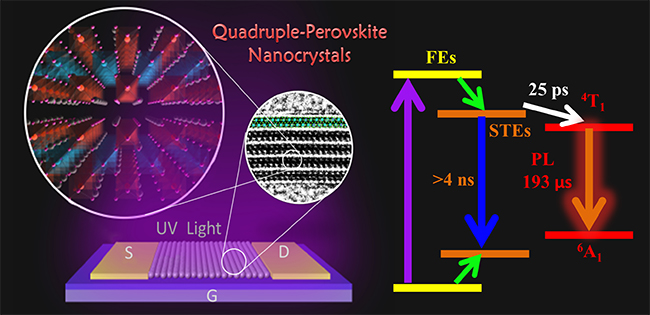In recent years, lead-free halide perovskite nanocrystals have been drawn more and more attention due to their low toxicity, high stability and chemical diversity.
It is important to reveal the carrier dynamics of the novel lead-free perovskite nanocrystals and to apply them effectively in the field of optoelectronic devices.
A research group led by Prof. HAN Keli from the Dalian Institute of Chemical Physics of the Chinese Academy of Sciences reported the luminescence enhancement mechanism of a series of new lead-free quadruple halide perovskite nanocrystals, and prepared high-performance photodetectors.
This study was published in Adv. Mater. on January 25.

Efficient luminescent halide quadruple‐perovskite nanocrystals via trap‐engineering for highly sensitive photodetectors (Image by YANG Bin and BAI Tianxin)
The researchers reported for the first time a series of quadruple perovskite colloidal nanocrystals with ordered vacancies. By alloying Cs4MnBi2Cl12 nanocrystals, the fluorescence quantum yield could be increased by nearly 100 times.
Carrier ultrafast dynamics studies found that in the quadruple perovskite nanocrystals, free excitons were rapidly self-trapped as "self-trapped excitons", and a self-trapped exciton-assisted donor-acceptor (Mn2+) occured energy transfer process. Alloying could eliminate the ultra-fast defect state trapping process that competed with energy transfer, and increased the crystallinity of the nanocrystals, thereby improving the luminous efficiency.
Based on the alloyed quadruple perovskite nanocrystals with high crystallinity and long carrier lifetime, the researchers prepared a photodetector, which had ultra-high responsivity. The sensitivity was much higher than the previously reported photodetectors based on lead-free perovskite nanocrystals.
This work shows that the quadruple perovskite type nanocrystal opens up new possibilities for photovoltaic applications.
This work was supported by the National Natural Science Foundation of China. (Text by YANG Bin and BAI Tianxin)